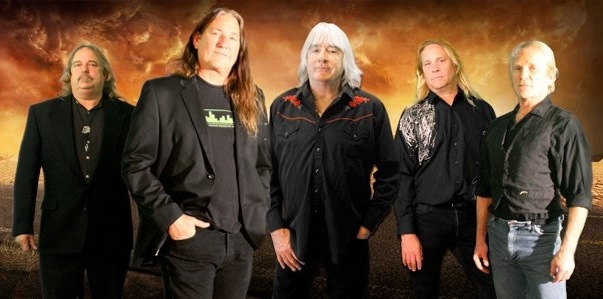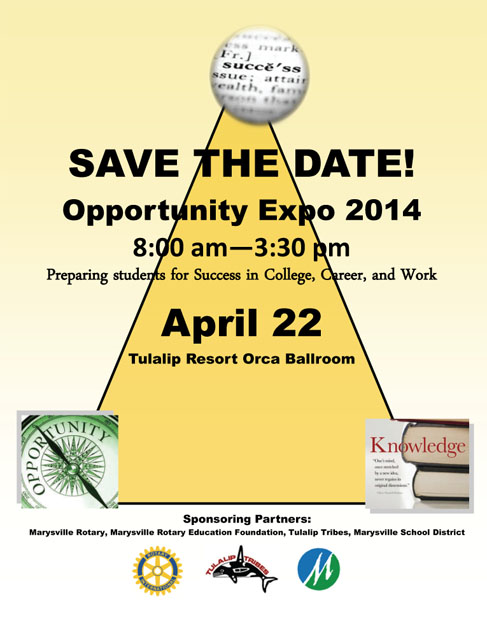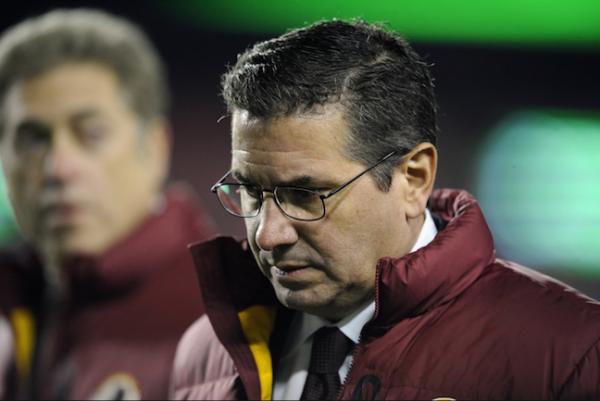Opportunity Expo 2014, April 22, Tulalip
Whitewashing Redskins Tour Gets Navajo Code Talkers Assoc. Endorsement
Dan Snyder, owner of the Washington Redskins, has been trying to sway public opinion to support his football team’s racist name for years now. He’s dangled money in front of needy schools in and around Pine Ridge. He tried—unsuccessfully—to get Haudenosaunee leaders to say disparaging things about Oneida Nation Representative Ray Halbritter, who launched the Nation’s campaign to change the offensive name. He got Jennifer Farley, former high level White House employee during the George W. Bush administration, who was on the receiving end of gifts from disgraced former Republican lobbyist Jack Abramoff, to facilitate a meeting with the Poarch Band of Creek Indians and other Indian leaders—who have been asked to sign non-disclosure agreements about what’s been said and done at the meetings. He’s waved tempting 50-yard-line D.C. game tickets and Super Bowl tickets under the noses of lobbyists and leaders, and presented a poorly orchestrated series of online endorsements by fans who are supposedly Native (mostly claiming Cherokee heritage) in an effort to prove the team’s ugly name is not offensive to Indians.
RELATED: Former Abramoff Associate Arranges Daniel Snyder Meeting With Poarch Band
RELATED: Redskins Run the Wrong Play, Again, With ‘Community Voices’ Campaign
And now, in a sad turn of events, he’s managed to snare the endorsement of seven World War II veterans. After months of courting support in Indian country, Snyder finally chalked up a big success: Seven octogenarian Navajo Code Talkers have endorsed the Redskins name and mascot. But judging from the reaction in Indian country, it could be his greatest misstep yet in this sordid campaign.
The endorsement was approved at a meeting of the Navajo Code Talkers Association (NCTA) in Window Rock, Arizona on February 28 – and was met with outrage from the descendants of code talkers actively involved in the association and devoted to honoring the legacy of their fathers and grandfathers. Much of their ire is directed at Association Chairman Peter MacDonald, who they allege has “hijacked” the NCTA and manipulated the code talkers to endorse the name for his own benefit.
In an interview with Indian Country Today Media Network, MacDonald vigorously denied having any financial involvement with the Redskins team. “There’s been all kinds of rumors and innuendos and theories going around about what our relationship with the Washington Redskins is all about. We wanted to set the record straight. There have been calls that Redskins paid us money… this is all totally wrong. Let me say this: The Redskins’ invitation and visit by Navajo Code Talkers was totally, totally funded by Redskins… to honor the Navajo Code Talkers. It was completely initiated by the Redskins as part of their annual tribute to all armed forces.
“The Navajo Code Talkers weren’t paid one cent to be there, nor were there any promises made about donations… ”
Reports of the NCTA endorsement showed up on Facebook late in the afternoon of February 28, and the news spread quickly. Here are a few typical posts. (Both the Facebook link and people’s names have not been used in order to protect their privacy.)
“People are crying. I almost threw up when I read it.”
“Sad day… so much for honor.”
“Rather give more attention to the medicine man association… code talkers have become nationalist puppets and fall for anything.”
Several Navajo descendants and other Navajo citizens expressed suspicion about MacDonald and his motives. Their common theme was, “He divided the Nation.” A former Navajo Nation president, MacDonald was removed from office by the Navajo Tribal Council in 1989 under suspicion of accepting kickbacks from contractors and corporations. The chaos that followed led, a few months later, to a riot in Window Rock in which two MacDonald supporters were shot to death and tribal police officers were injured. “It was an event that would forever change life for many people on the Navajo Nation,” the Navajo Times reported.
MacDonald was tried and sent to federal prison in 1992 for 107 violations of U.S. law, including charges of fraud, extortion, riot, bribery, and corruption. He served eight years of a 14-year sentence and was released in January 2001, when his sentence was commuted by then-President Bill Clinton on his last day in office.
MacDonald was voted president of the NCTA in January 2012.
***
In November, Navajo Nation Councilman Joshua Lavar Butler condemned what he called team officials’ “antics to use our beloved and cherished Navajo Heroes as pawns in their Public Relations battle to perpetuate this indignity and ignorance.”
Butler has drafted a legislative resolution opposing the Redskins name and distancing the Navajo government from the NCTA. He stressed that people should differentiate between the NCTA and the Nation’s government. “I must remind the public that the endorsement is not from the Navajo Nation government or the Navajo Nation as a whole,” he said.
“I know this really hurts our inter-tribal relationships around the country,” Butler added. ”As a council member, I’ve been very involved statewide and on the national level with advocacy efforts with other tribal leaders and something like this, it does affect unity and our working relationships inter-tribally.”
The Navajo Nation is not a member of the National Congress of American Indians, which recently published a white paper called “Ending the Legacy of Racism in Sports & the Era of Harmful ‘Indian’ Mascots,” but it does partner with NCAI on issues of common concern.
“The NCTA is putting us in an awkward position because some tribes, especially on the east coast, are fighting this aggressively. At the end of the day, we have to work with those tribes as well and the NCTA is sending the wrong message by endorsing the utilization of that term,” Butler said. “It’s very upsetting, it’s shameful, it’s wrong, it’s derogatory and the Redskins should be ashamed of themselves.”
***
MacDonald and members of the NCTA met Snyder last fall after he began his tour of Indian country, seeking support for his team name and mascot. A friend of Snyder’s told the Washington Post that the trips to Indian country were motivated by Snyder’s “feelings about the pain and depression – depression is the word he has used with me – of Native Americans who have no jobs, who have obesity issues, whose children are suffering.”
The trips also coincide with launching of a national campaign against the team name supported by the Oneida Indian Nation (which owns ICTMN) called “Change the Mascot.”
RELATED: Halbritter Brings ‘Change the Mascot’ Campaign to USET
In recent months, Snyder and his team officials have visited the Poarch Band of Creek Indians, a tribe under fire from other tribes for building a casino on Hickory Ground, a site that’s sacred to the Muscogee Creek Indians, and the poverty-stricken Zuni Pueblo in New Mexico, among other tribes. Redskins spokesman Tony Wyllie told the Washington Post that Snyder and company have taken more than a dozen unpublicized trips around Indian country.
RELATED: The Battle For Hickory Ground
While those trips were unpublicized, Snyder’s pursuit of the Navajo Code Talkers was no secret. In late November, the Redskins plane flew MacDonald, and members George James Sr. and George Willie Sr. from Gallup, New Mexico to D.C. for the November 25 Washington-San Francisco game to “honor” them, accompanied by a blitz of media attention.
Suzan Harjo wrote of the event: “The Redskins’ ‘honoring’ of Navajo code talkers consisted of four frail veterans standing in the end zone and receiving a round of applause. Three of the four Navajo elders wore Redskins jackets, with the new-clothes price tags still hanging at their wrists. These seniors probably thought this was another in a long line of recent recognitions of their WWII achievements some 70 years ago, rather than any implied endorsement of the team’s name.”
Related: Red*kins ‘Honor’ Codetalkers—How Low Will They Go?
On hearing about the Code Talkers endorsement of the Redskins, Harjo honed in on MacDonald’s involvement. “He has a long history of exploiting his people,” she said, “and I think this is an example of that.”
***
MacDonald has a simple explanation for the endorsement: he doesn’t think there’s anything wrong with the name, and he claims other Navajo feel the same way. “So far as we’re concerned, so far as people are concerned here at Navajo, redskins have always meant Native Americans or Indians to us – nothing more. So I don’t know who decided to make that a slur word or offensive. To us, redskins, whiteskins, blackskins, yellowskins, brownskins – we here on earth did not create the color of human skins; it was the Great Spirit that created us with different colors and we honor His creation and have no problem with anyone using those colors to identify the Lord’s creation.”
Asked if he’d mind if his grandchildren were called redskins, he said, “No! As a matter of fact we have schools right here on Navajo Nation – Red Mesa school – it’s a Navajo high school. The school [nickname] name is Redskins.”
He said he was not familiar with the origins of the name, or the 1755 Phips Proclamation in Maine that detailed the bounty prices the colonial government paid for Indian scalps, “but humans around the world have different colored skin – what’s wrong with calling them by the color of their skin?” he said.
The suggestion that most Native Americans and others see the name as a hateful racist word set MacDonald on an anti-media diatribe. “You press people! I don’t know what’s wrong with you! We have so many issues with Native American people – states, the federal government stealing our water, taking our land. There’s poverty and high unemployment on Indian reservations. Why don’t you go over there and report those things? Is the change of [the] name going to change poverty on Navajo? Will that create thousands of jobs?
“There’s the cancer rate, as well as diabetes, alcoholism, the suicide rate – all much higher than outside society. It’s a third-world nation in the back door of the United States. Report that! Forget about this name change business. We can talk about that after we put the Indian back on equal footing with the rest of the world.”
MacDonald brushed aside the fact that studies show the offensive name is emotionally and psychologically harmful to Indian children. “The children here at Navajo at Red Mesa don’t want to change their name, they want to remain redskins,” he said.
***
The NCTA endorsement of the Redskins name passed by a vote of 7-0-0, meaning only seven code talkers attended the meeting. MacDonald said there are currently around 40 code talker members and all of them were notified of the meeting, but several descendants said their fathers and grandfathers were not notified.
Ron Kinsel, son of Code Talker John Kinsel, added that his dad did not approve of the endorsement of the Redskins name or the way the vote was conducted. “It was done without the association’s awareness. They were trying to pass it without a quorum,” Kinsel said.
MacDonald told ICTMN that the association’s bylaws define a quorum as 10 percent of the total member and therefore the seven-member vote was legitimate. However, Section 13 of the NCTA bylaws says, “The greater of ten (10) voting members or ten (10) percent of the voting members” constitutes a quorum, meaning that 10 members were required for the vote. The bylaws also mandate that “Notice of any meeting shall be given by oral or written notice delivered to each member. . . not less than ten (10) days nor more than fifty (50) days before the date of the meeting.”
The NCTA endorsement has mobilized the code talkers’ descendants into action. A meeting for concerned descendants of Navajo Code Talkers has been scheduled for Saturday, March 15, 2014 at 9:00 a.m. at Cafe Iina at the Navajo Nation Museum. Duvonne Manuelito, whose late grandfather James Manuelito was one of the original 29 code talkers, said it’s an opportunity for all the code talkers’ descendants to come together and plan a strategy to protect their fathers’ and grandfather’s legacy. “We need to let people know there’s another side to what’s going on.”
Read more at http://indiancountrytodaymedianetwork.com/2014/03/10/whitewashing-redskins-tour-gets-navajo-code-talkers-assoc-endorsement-153932?page=0%2C4Klamath Tribes And Ranchers Seek Water Solutions In New Agreement
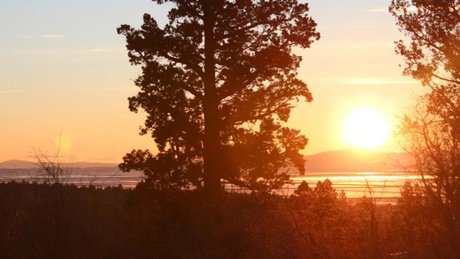
Devan Schwartz, March 5, 2014 OPB
An agreement announced Wednesday between ranchers and Native American tribes seeks to resolve contentious water rights issues in the Klamath Basin, a drought-ridden region spanning southern Oregon and northern California.
Amidst a deep drought last summer, the Klamath Tribes and the federal government called on their senior water rights –- meaning they received access to limited water supplies.
As a result, irrigation water was cut off to thousands of acres of Klamath Basin ranchland. This created millions of dollars in losses.
The new agreement seeks reduced water demand by ranchers, along with increased river restoration and economic development for the Klamath Tribes.
Tribal chairman Don Gentry said it wasn’t easy getting all the stakeholders in the Klamath Basin to reach common cause on such a contentious issue.
“It’s nothing short of remarkable that we’ve come to this point,” he said.
Last summer, Larry Nicholson saw irrigation water shut off to his family’s cattle ranch. He hopes that won’t happen again.
“Everybody can have water, where most people couldn’t before,” Nicholson said.
Proponents of the new agreement say it will bring stability to the region and represents an important step forward in a generations-long struggle.
But some conservation groups disagree.
Jim McCarthy of Oregon WaterWatch said the agreement doesn’t go far enough in limiting the amount of water that people will want to withdraw — water that others want to remain in streams to help fish and wildlife . “It’s just not enough water to solve those problems,” he said.
Drought conditions could be worse next summer and fall than they were in 2013. The Klamath Basin currently has a snowpack about 40 percent below what it was last year at this time, according to Natural Resources Conservation Services data.
The new agreement calls for an additional 30,000 acre-feet of water to help fill Upper Klamath Lake –- the source for both the Klamath River and the Klamath Project, one of the largest federal agricultural projects in the country.
This would be accomplished through a combination of reduced ranching through a land retirement program and increased management of streamside areas along Upper Klamath Lake tributaries.
As far as economic development, an additional $40 million would be appropriated for the Klamath Tribes.
Tribal Chairman Don Gentry said this agreement is historic and paves the way for a better economic situation for the Klamath Tribes, in addition to better protecting the natural resources of historic tribal lands.
The new agreement still faces votes by the ranching and tribal communities, and would be folded into federal legislation that is likely to reach opposition in a divided congress.
The legislation would combine the Klamath Basin Restoration Agreement and the Klamath Hydroelectric Settlement Agreement, which stipulates the removal of four hydroelectric dams from the Klamath River.
But Gov. Kitzhaber’s natural resources advisor Richard Whitman expressed confidence that the continued leadership of Sen. Ron Wyden could get the bill approved in Congress by the end of the year -– and help solve the water crises in the Klamath Basin.
An Undammed River’s Sediment Brings New Life Downstream
Katie Campbell, KCTS9
PORT ANGELES, Wash. — Anne Shaffer sits on the sandy shoreline of the Elwha River and looks around in amazement. Just two years ago, this area would have been under about 20 feet of water.
So far about 3 million cubic yards of sediment — enough to fill about 300,000 dump trucks — has been released from the giant bathtubs of sediment that formed behind the two hydroelectric dams upstream. And that’s only 16 percent of what’s expected to be delivered downstream in the next five years.
All of that sediment is already reshaping the mouth of the Elwha, which empties into the Strait of Juan de Fuca on the northern shore of Washington’s Olympic Peninsula.
The depth at the mouth of the river has changed by about 50 feet. Long, charcoal-colored sandy beaches have formed where there once only smooth, platter-sized cobblestones.
Watch video report:
“This place is like Christmas,” says Shaffer, a marine biologist and the executive director of the Coastal Watershed Institute. “Everyday you come out here and its something new.”
Shaffer is leading a team of researchers who are studying the Elwha’s nearshore area, where the river’s freshwater meets the saltwater tides. Shaffer explains that until recently this area was starved of sediment, and now a whole new ecosystem is forming. Her team is trying to find out what tiny creatures are moving in.
They’re searching for evidence that species like sand lance and surf smelt are using this area as spawning grounds. These tiny fish are a common food sources for juvenile salmon.
Sand lance, she explained, require a very fine grain sediment in order to lay their eggs.
“We now are surrounded by the exact grain size that sand lance need to spawn,” she says.
The team scoops up bags of sand to test in the lab. So far they haven’t found evidence of sand lance spawning in this new habitat, Shaffer says. But they have found that surf smelt are spawning in areas where sandy substrate has built up.
During recent fish census surveys of the Elwha’s estuary, Shaffer’s team counted baby chum salmon in numbers they haven’t seen in years, if ever, Shaffer said. And they’ve also found a number of eulachon, a type of smelt that was once an abundant food source for coastal tribes. The eulachon is now listed as threatened under the Endangered Species Act.
“As soon as this habitat is available, these fish are using it,” Shaffer says. “None of us anticipated how quickly it would occur. I’d never seen a eulachon in the estuary before, but in the last three months, every time we survey, we see them.”
The drone of a single-engine plane causes Shaffer to look up and shield her eyes.
“I bet that’s Tom,” she says with a smile.
A Bird’s Eye View
Port Angeles pilot and photographer Tom Roorda has had one of the most unique perspectives during the last two and a half years while the dams have been slowly dismantled. He started taking land-survey photos of the Elwha eight years ago. Back then his photos were used to help the federal Bureau of Reclamation prepare for dam removal.
Today his jaw-dropping aerial photos capture the giant plume of sediment flowing out of the mouth of the Elwha.
“Until I started taking these pictures, no one had any idea how much sediment was coming down or how far it extended out into the strait,” Roorda said.
The flush of sediment has moved the mouth of the Elwha north by about 300 feet, creating a long skinny spit that extends into the Strait of Juan de Fuca. The area that used to serve as the Elwha’s estuary has been inundated with freshwater and a new estuary is forming downstream.
“As soon as it starts to rain that sediment gets washed down into the river and we get these big gulps of sediment coming down,” Roorda said.
This winter’s rains have continued to flush sediment downstream, so much so that the river’s flow is currently 10 times higher than normal. While all that sediment is ideal for building nearshore habitat, some worry the water will be too murky for salmon. Sediment can clog and irritate their gills and make it difficult to find food.
But Shaffer for one, isn’t concerned.
“Salmon are brilliant,” she said. “They have evolved over millenia. If they’re given a chance to acclimate to it, they will.”
The First Leap?
Today the entire length of Elwha looks like a free-flowing river. That’s because recent storms have submerged the remaining 25 or so feet of the Glines Canyon Dam.
From webcam images, it’s difficult to even identify the slope of what remains of the 210-foot spillway. This is causing some to wonder how much longer it will be before the first fish leap over the concrete barrier that remains.
It may take weeks or months, but when the first leap happens, it’s not likely to be a salmon.
“Steelhead are quite the athletes. A steelhead can leap up to 12 feet in a single jump,” said John McMillan, a NOAA biologist who is tracking fish recovery on the Elwha.
McMillan is betting on steelhead — trout that, like salmon, are born in freshwater streams before migrate to marine waters. He says he’s seen steelhead ascend a 35-foot cascading waterfall by taking a series of long leaps.
Researchers are using imaging sonar to track the different fish returning to the Elwha, and they’ve found that some steelhead have already returned to the lower Elwha, McMillan said. The bulk of the run, however, is expected to take place from April to early July, he said.
Dam deconstruction will pause May 1 to minimize disruption to the steelhead spawning season.
Removal of the Lower Elwha Dam finished in March 2012. The last of the rubble of the Glines Canyon dam is expected to be gone by September 2014.
CSKT to become first tribes to own a major hydroelectric facility
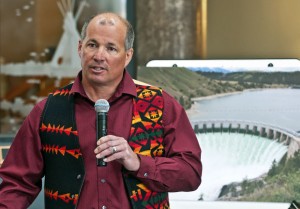
Vince Devlin, Buffalo Post
Almost 40 years after starting the process to acquire Kerr Dam, the Confederated Salish and Kootenai Tribes have almost reached the finish line.
And they’ll get there for a price that is tens of millions of dollars closer to what the tribes said it was worth than what PPL Montana wanted for it, the Missoulian reports.
The Flathead Indian Reservation tribes will become the first in the nation to own a major hydroelectric facility when they turn over $18.3 million. That’s the price set by the American Arbitration Association after weighing arguments from CSKT, which maintained the price should be $14.7 million, and PPL Montana, which said it should be nearly $50 million.
Extensive hearings on the price were held in January.
“This is a historic day for the Confederated Salish, Pend d’Oreille and Kootenai Tribes,” CSKT Chairman Ron Trahan said. “We’ve been working toward this for 40 years. It brings tears to my eyes, because it’s something we never quit on.”
The earliest the transfer of ownership can take place is Sept. 5, 2015.
New owners will mean a new name for the dam according to Brian Lipscomb, CEO of Energy Keepers, a federally chartered corporation wholly owned by the tribes. Completed in 1938, the dam was named after Frank Kerr, president of Montana Power Company at the time.
“We’ve been titled as visionary people, and it plays out,” council member Lloyd Irvine said at a press conference announcing the price. Acquisition of the dam “is one of the tools that ensures the future of our people.”
But another council member, Terry Pitts, urged caution.
“We should not be blinded by the bling,” Pitts said. “There will be a lot of issues that come with this. We need to be fully prepared.”
Possible Ancient Indian Cemetery Unearthed In Texas After Crew Finds Native American Bones
By Philip Ross, International Business Times
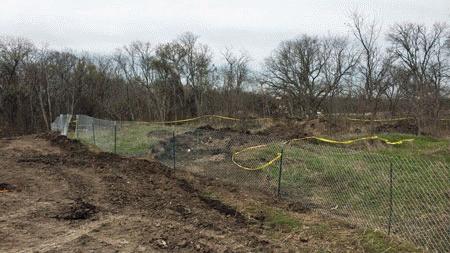 A construction crew in central Texas may have unearthed the remains of an ancient Indian cemetery. Earlier this week, human bones were discovered at the site of a future 225-home subdivision in Round Rock, about 100 miles northeast of San Antonio. Work was halted after the bones were discovered and the police were called in to investigate.
A construction crew in central Texas may have unearthed the remains of an ancient Indian cemetery. Earlier this week, human bones were discovered at the site of a future 225-home subdivision in Round Rock, about 100 miles northeast of San Antonio. Work was halted after the bones were discovered and the police were called in to investigate.
According to Associated Press, after examining photos of the bones, an FBI anthropologist said that they appeared to be the remains of a Native American. On Friday, Texas State University anthropologists were called to the site to excavate the area, which has long been a popular spot to search for Indian arrowheads.
Because the possible Native American remains were found on private land, the developers, KB Home, are responsible for preserving the site or hiring a professional archaeologist to remove and relocate the remains. Texas state law says that even a single body constitutes a cemetery and a qualified anthropologist must determine if there are other remains in the area.
“You get more than a couple and people start to go, ‘whoa,’” Mark Denton, with the Texas Historical Commission, told AP. “We better wait and back off. We have to figure how we can preserve and protect this area rather than remove all of them.”
Historically, central Texas was home to several Native American tribes, including the Tonkawa, Apache and Comanche. According to the Star-Telegram, if investigators can determine to which tribe the ancient remains belonged, they would contact any present-day members of the tribe so the remains could be handled according to that group’s customs.
Tribes, BIA and BLM collaborate on oil, gas operations
By The Ranger staff reports
The Arapaho and Shoshone tribes and the Department of the Interior, through the Bureau of Indian Affairs and the Bureau of Land Management, signed a memorandum of understanding Feb. 25 in Fort Washakie.
Through the MOU, the parties said they will engage in a cooperative environmental program to promote compliance on oil and gas properties by lessees and operators on the Wind River Indian Reservation.
“This MOU is a good opportunity for all of us to start fresh, to be on the same page and to work toward the same goals,” said BIA acting Rocky Mountain regional director Darryl LaCounte.
Specifically, the MOU outlines a process and timelines for the parties to:
– review all ongoing oil and gas operations on the reservation with tribal ownership interest to identify actual or potential adverse environmental effects;
– identify prospective sources of federal funding to the tribes to support monitoring, inspection and enforcement;
– develop an environmental plan for oil and gas operations; and
– formalize a structure for future communications between the parties regarding environmental concerns arising from oil and gas operations.
“We look forward to working collaboratively with the Arapaho and Shoshone tribes, as well as with the BIA, to manage oil and gas activities on the Wind River Indian Reservation,” said BLM Wyoming state director Don Simpson.
For more information, call BIA realty officer Marietta Shortbull at 332-4639 or BLM resource adviser Stuart Cerovski at 332-8400.
Dead eagles found in Neb. used by Native Americans
By Associated Press
NORTH PLATTE, Neb. (AP) — The carcasses of dead bald and golden eagles found in Nebraska are collected and recycled for religious purposes.
The North Platte Telegraph reports (http://bit.ly/1nwRtQ2 ) the state is part of an unusual federal recycling program that provides parts of eagle carcasses to Native Americans who hold valid permits.
The feathers and other body parts of eagles are considered sacred by some Native Americans. But federal laws designed to protect the birds make it illegal for most people to possess any part of a golden or bald eagle.
Lauren Dinan with the Nebraska Game and Parks Commission says the state recently sent 37 eagles to the U.S. Fish and Wildlife Service National Eagle Repository in Commerce City, Colo.
___
Information from: The North Platte Telegraph, http://www.nptelegraph.com
Yankton Sioux Tribe road projects take a new path
By Associated Press
MARTY, S.D. (AP) — As the Yankton Sioux transportation planner, Wesley Hare Jr. received reports of a dangerous intersection often used by tribal members.
Accidents and near-misses were occurring because of a blind spot near the junction of S.D. Highway 46 and a Bureau of Indian Affairs road leading to Marty, Hare said.
Hare contacted the South Dakota Department of Transportation about the problem.
“A (DOT) person was out there, and he observed for a week and saw the near misses,” the tribal planner said.
A road turnout was constructed for safety reasons, Hare said. “We have gotten a lot of feedback and good comments on it,” he added.
The Yankton Sioux isn’t the only tribe with such issues. Transportation needs remain a challenge for Indian Country. In order to share their experiences, nine tribes from across South Dakota have created the Tribal Transportation Safety Summit.
The Yankton Sioux Tribe recently hosted the fourth annual summit at Fort Randall Casino. The two-day meeting drew around 100 officials — double the first summit and the largest turnout in the event’s history, Hare said.
The nine tribes that took part were the Rosebud, Oglala, Crow Creek, Lower Brule, Standing Rock, Cheyenne River, Flandreau, Sisseton-Wahpeton and Yankton.
The Yankton Sioux highway department not only cares for tribal roads but also partners with Charles Mix County and the state’s transportation department, he said. “As far as tribal roads, we have only 28 miles. But in conjunction with the county and state, we have maybe 1,200 miles,” he said.
During last month’s highway summit, Hare learned of the vast road miles that other tribes maintain.
“Marty to Greenwood is only six miles for us,” he said. “But communities (in other parts of South Dakota) may be 30 to 50 miles apart, and they have to take care of those long stretches.”
The Federal Highway Administration has encouraged these types of tribal conferences across the nation, according to June Hansen the tribal liaison of the state’s transportation department.
“During the annual meetings that SDDOT holds with each of the nine tribes, the topic of transportation safety and ideas to improve safety was a recurring theme,” she said. “The SDDOT was happy to partner with the nine tribes and a number of other agencies (on setting up the summit).”
Those agencies include the federal transportation agency’s South Dakota division office, Bureau of Indian Affairs, South Dakota Department of Public Safety and the Northern Plains Tribal Transportation Assistance Program.
“The real heart of each of these summits is the host tribe, and all the host tribes have done an outstanding job with each of the summits,” Hansen said. “That is especially true for Wesley Hare and his staff with the Yankton Sioux Tribe. They really outdid themselves with some truly unique and special events like the honoring of the YST Code Talkers from World Wars I and II.”
At last month’s summit, the tribes also talked about cooperation between their road and police departments to cut down on drunk driving and related fatalities.
The Yankton Sioux presentation was given by Hare and Louis Golus Jr., the road maintenance supervisor. Besides the Highway 46 turnout, Yankton Sioux Tribe successes include the installation of reflectors around Marty and the road leading to Greenwood.
Among other projects, the Yankton Sioux Tribe has worked with other entities on a Lake Andes walkway and welcome signs around Charles Mix County, acknowledging the Yankton Sioux traditional homeland.
In addition, the transit program, started in 2011, has grown rapidly, Hare said. The transit operates 18 hours daily, running a route of 16 stops. The tribe constructed 14 shelters for passenger waiting for rides.
Passengers rely on the transit for reaching destinations ranging from jobs and medical appointments to the Boys and Girls Club and Fort Randall Casino.
“Forty-five percent of our people don’t have any (personal) transportation at all,” he said. “The transit is a really growing program. The first year, during a month’s time, we had between 500 and 600 riders. Now, we are over 2,000 riders a month. It has just shot up.”
In his work with the federal government, Hare noted a shift from the Bureau of Indian Affairs to tribes. Tribes now take care of planning, hiring their own engineers and doing their own construction. In addition, funding goes directly to tribes rather than funneled through the bureau.
That isn’t to say the bureau and tribes have become disengaged, Hare said. “We keep in touch with the BIA in Aberdeen. We still use them for a lot of technical assistance,” he said.
Hare was elected chairman for the Northern Plains Tribal Technical Assistance Program, which serves 26 tribes. Adequate funding remains a concern at all levels, he said.
In that respect, the annual highway summits take on growing importance as tribes make the most of their resources, Hansen said.
“The networking between the various tribal agencies that work to improve transportation safety — whether they are from the engineering, education, enforcement or emergency services — has grown each year,” she said.

